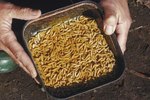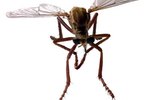
Maggots are young flies at larval stage of the flies’ life cycle. Grubs are young beetles in the second stage of the beetles’ life cycle. Though maggots and grubs look very similar, flies and beetles are different insects. Maggots live in areas with abundance of food materials that are rotting, since they are voracious feeders. Grubs feed on roots and live in the soil.
Life Cycle
The life cycle of grubs is longer than that of maggots. Grubs take approximately a year to transform into pupae. Female beetles spend two to three weeks laying eggs in moist soil. After two weeks the eggs hatch into larvae. Female flies, on the other hand, lay eggs in rotting material. The eggs hatch after eight to 20 hours, depending on the temperature of the environment. Both types of larvae start feeding immediately after they hatch. Maggots feed on the rotting and decaying materials where the eggs were laid, while grubs feed on moist soil.
Uses
Grubs are destructive while maggots are beneficial in various ways. Grubs feed on plant roots and moist soil, leading to severe damage of turf and lawns. Maggots are used to catch fish by some fishing enthusiasts. Amazingly, they also have a medicinal use. Doctors can use certain types of maggots to treat wounds, because they eat dead tissue while leaving healthy tissue alone. They can promote healing when placed in the wound.
Diseases
Though maggots are sometimes beneficial to human beings, infestations can be dangerous. Some species of maggot are harmful since they feed on decaying and live materials alike. If such a species happens to lay eggs on a body opening such as a mucous membrane or edge of a wound, the maggots damage healthy tissue and cause damage. Such maggots can cause an infection known as myiasis. Grubs do not cause diseases; rather they damage lawns and turfs.
Identification
Maggots are smaller than grubs. Their size and color depends on their stage of development. Maggot larvae start out at 2 to 3mm in length, growing to 15 to 20mm. Their color ranges from creamy white to light brown. Maggots are legless, and therefore move by crawling. They have a brown head with a pair of hook-like parts that help them in feeding. Grubs are white in color with a length of about 20 to 45mm depending on the species. They have a C-shaped body, three pairs of legs and a brown head.
References
Resources
Photo Credits
-
Ablestock.com/AbleStock.com/Getty Images
Writer Bio
Kendal Elizabeth has been a professional writer and editor since 2001. She has specialized in writing pet-related topics, home decor and gardening. Her work has appeared on several online and offline publication. Elizabeth holds a Bachelor of Science in Animal Science with a minor in marine biology from Cornell University.




